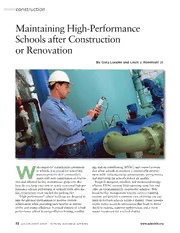
ERIC EJ919354: Maintaining High-Performance Schools after Construction or Renovation PDF
Preview ERIC EJ919354: Maintaining High-Performance Schools after Construction or Renovation
construction Maintaining High-Performance Schools after Construction or Renovation By Gary Luepke and Louis J. Ronsivalli Jr. W ith taxpayers’ considerable investment ing, and air-conditioning (HVAC) and control systems in schools, it is critical for school dis- that allow schools to maintain a comfortable environ- tricts to preserve their community’s ment while reducing energy consumption, saving money, assets with new construction or renova- and improving the school’s indoor air quality. tion and effective facility maintenance programs. But Properly designed, installed, and maintained energy- how do you keep your new or newly renovated high-per- efficient HVAC systems keep operating costs low and formance schools performing at optimal levels after the offer an environmentally responsible solution. Web- last construction truck has left the parking lot? based facility management systems connect building “High-performance” school buildings are designed to systems and provide a common view of energy-use pat- link the physical environment to positive student terns in multiple schools across a district. These systems achievement while providing such benefits as sustain- enable better access to information that leads to better ability and energy efficiency. A critical element of a high- decision making, superior performance, and a more performance school is energy-efficient heating, ventilat- sound investment for a school district. 32 JULY/AUGUST 2009 | SCHOOL BUSINESS AFFAIRS www.asbointl.org Approaches to Maintenance High Performance Buildings Preventive and predictive maintenance programs allow for Life™ Action Plan school administrators to understand system perform- How do you know what high-performance systems ance and anticipate and plan for possible system failure, are right for your facility? A basic audit and analysis ultimately helping to protect the school’s investment should help determine the answers to the following and ensuring that the HVAC and control systems offer questions: maximum energy efficiency. • What are the critical systems in the facility for According to the Federal Energy Management which performance criteria have been or should Program’s Operations and Maintenance Best Practices: be established? A Guide to Achieving Operational Efficiency, Release • What are performance criteria for the equipment 2.0, maintenance programs can save 5% to 20% on (efficiency, capacity, control, etc.) and what can energy bills without significant capital investment. be used as a baseline against which you can com- Although maintenance will not improve system efficien- pare future performance? cy above and beyond its original design performance, a • Are there more urgent issues that should be con- structured maintenance program can help prevent the sidered in your systems analysis? deterioration of system or component efficiency over • Do you have adequate redundancy for critical sys- time or help restore efficiency to original design per- tems? formance levels. • Do you have a contingency plan to manage inci- Today’s robust and affordable technology has spurred dents? a conscious movement toward more “need-based” serv- • What does the current maintenance program look ice in which regular maintenance procedures are per- like and can you identify “gaps” that could cause formed only when testing or documentation indicates concerns about performance degradation? they are necessary, rather than when the calendar indi- • Do you have manufacturer-recommended mainte- cates it’s time for maintenance. A maintenance program nance practices that can enhance the current pro- based on the performance “outcomes” of equipment gram? and systems is referred to as performance-based mainte- • Can you identify testing and diagnosis procedures nance. The goal of performance-based maintenance is to help you move toward a more proactive main- to sustain original design performance outcomes (capac- tenance future. ity, efficiency, and reliability). Three other approaches to maintenance help ensure a healthy and energy-efficient learning environment: A fourth level of maintenance, reliability-centered • Deferred maintenance, also known as reactive maintenance, features a more formal approach to maintenance, refers to the absence of a formal main- random system testing, continuous monitoring, and tenance program. This approach appears to be a documented remedial measures for out-of-tolerance short-term cost-saving bridge, but in reality, it quick- metrics. It is the basis for sustaining a High ly becomes the most-expensive cost-of-ownership Performance Building for LifeTM. option. • Preventive maintenancerefers to the traditional Cost Benefits to Communities practice of scheduling maintenance tasks at prede- According to the U.S. Environmental Protection Agency, fined frequency intervals and then performing those high-performance schools promote higher student tasks per prescribed dates, whether or not they are achievement, increased average daily attendance, needed. This practice also implies that the date-based increased teacher satisfaction and retention, reduced lia- task schedule will ensure performance outcomes, but bility exposure, and reduced environmental impact. the completion of tasks and performance outcomes High-performance schools also have decreased oper- are rarely related. ating costs, limited liability, and reduced environmental • Predictive maintenancerefers to the use of non- impact. In the face of those results, it’s hard to argue destructive testing, predictive technologies, and diag- against them. Don’t our children, educators, and com- nostics to determine operational readiness and pro- munities deserve the opportunities these schools afford? jected performance and actual maintenance needs. Predictive maintenance technologies include the use Gary Luepkeis a senior principal systems engineer for the of ultrasonic testing, digital infrared thermography, Trane commercial systems business based in LaCrosse, vibration analysis, electromagnetic eddy current tube Wisconsin. testing, oil spectroanalysis, refrigerant analysis, and Louis J. Ronsivalli Jr. is the service offers development leader other nondestructive testing–based applications. of Americas Services and Contracting for Trane. www.asbointl.org SCHOOL BUSINESS AFFAIRS | JULY/AUGUST 2009 33
